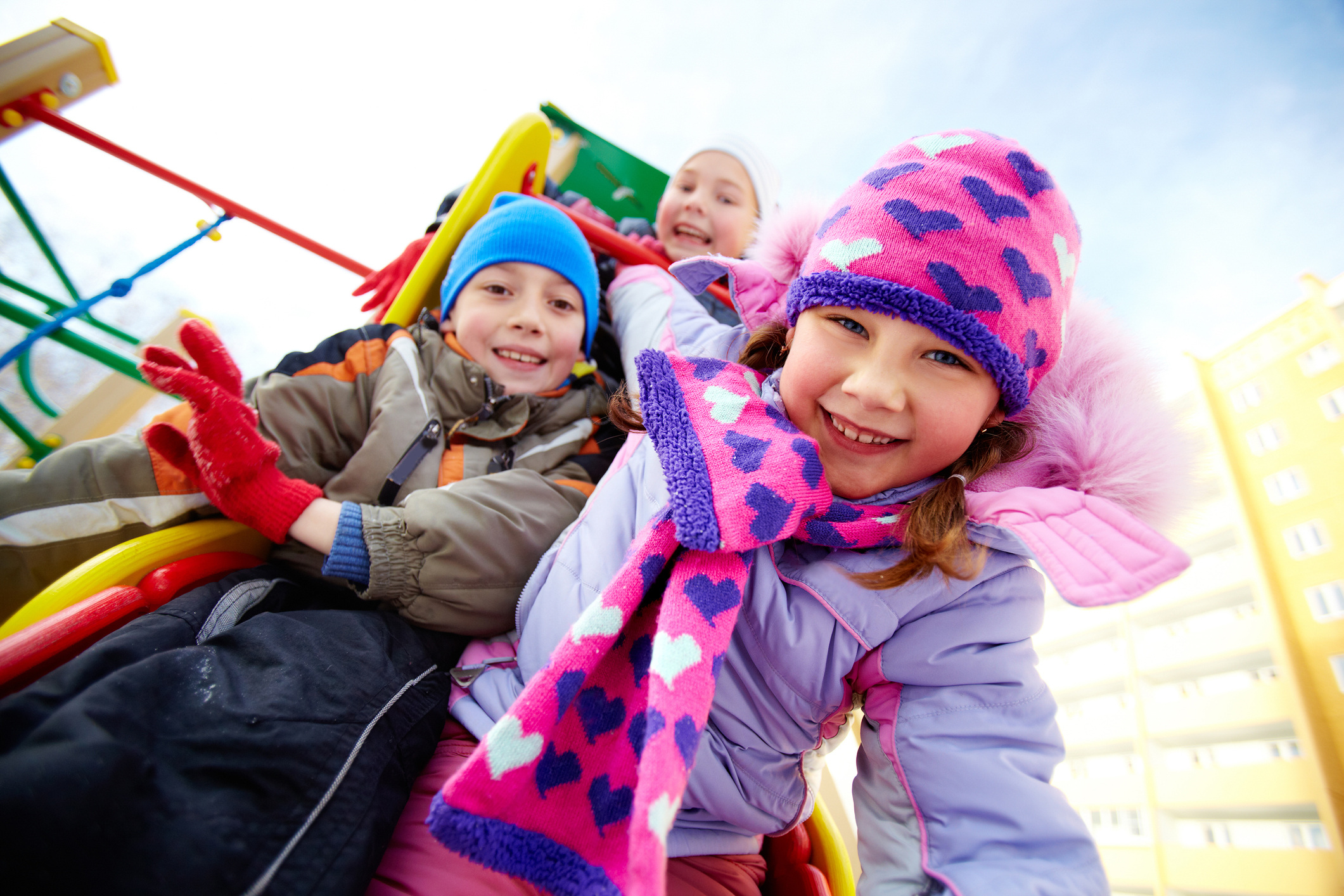Why Letting Your Kids Play Outside in Winter is the Right Move
Posted by May Recreation Content Team on

Baby, it’s cold outside! The winter holidays conjure up warm images of stockings hung by the chimney with care and families gathered with cups of hot cocoa around a crackling fire.
It’s also a time of year when children spend too much time indoors as temperatures drop outside and parents fear letting them play in the cold weather is unhealthy. Health officials, however, say that letting your kids play outside in winter is the right move!
“Experts says children should stay physically active for at least one hour per day and time spent in colder weather may offer even more health benefits,” says Atrium Health.
The arguments for heading to the backyard or the local playground or park in cold weather range from improved cardiovascular health to enhanced cognitive function to resilience building to mood enhancement and beyond.
And as a bonus, your family won’t have to fight cabin fever over the winter months – let’s face it, there are only so many times you can play Pictionary or Uno, hunt for that missing jigsaw puzzle piece, or watch Frozen for the fourteenth time.
MythBusters: Catching a Cold … From the Cold!
Somewhere at this very moment, there is a well-meaning parent, grandparent or caretaker telling a kid that they will get sick if they go out in the cold … especially with wet hair!
And, doctors tell us, it’s simply not true!
“Colds are caused by viruses, so you can't catch a cold from going outside with wet hair. And wet hair won't make you more attractive to germs,” explains the Mayo Clinic. “The same is true with respect to dressing for cold temperatures. While it might be optimal to dress in warmer clothes when it's cold outside, research indicates that cold weather — just like going outside with wet hair — doesn't make you sick.”
But people, especially kids, are always getting sick when it’s cold outside. This is true and it’s most likely because they are indoors around other sick people. Bundling up and playing outside is a healthier option than indoor spaces.
"Exercising outdoors means you can avoid gyms, as all the bacteria and germs that are brought in get recycled repeatedly through air vents," Timothy J. Cirone, MAEd, LAT, ATC, wellness coordinator with Employer Solutions told Atrium Health. "Despite common misconceptions about staying indoors to avoid a cold, you may be more likely to pick up an illness from the gym than outdoors."
The Health Benefits of Playing Outside in the Cold
Now that we have busted the “you will catch cold playing outside myth” then we can focus on the fact that there are some real health benefits to playing outside in the cold.
“Children need to play outside every day, even in winter. Going outside to run, jump, yell, and wiggle allows children to use their large muscles and work off extra energy. Moving out into the fresh air is also healthier for children than keeping them inside a closed building where germs can easily spread,” says Penn State Extension.
Here are some of the health benefits that kids can get from putting on their coats, gloves and hats and heading outside in the winter:
- Boost Your Immune System: Atrium Health says that allowing children to come into contact with outdoor pests and bacteria in a natural way during the winter months can help them build up their immune system and make it less likely they will develop autoimmune disorders and allergies.
- Grab Some Rays and Vitamin D: One of the downsides of being cooped up indoors all winter is missing out on sunshine and its benefits of vitamin D. Intermountain Health says the best way to get vitamin D is naturally from the sun. The sun likes to play hide-and-seek a lot in the winter months, and health experts say you will need nearly two hours of sun exposure at noon to produce the right amount of vitamin D.
- Charge Up Your Cardio Health: Harvard Health explains that cold weather may actually improve endurance leading to better cardiovascular health. Dr. Adam Tenforde, an assistant professor of sports medicine and rehabilitation at Harvard-affiliated Spaulding Rehabilitation Network: “In colder temperatures your heart doesn't have to work as hard, you sweat less, and expend less energy, all of which means you can exercise more efficiently."
- Combat Childhood Obesity: Obesity is a big problem facing America, especially childhood obesity with some estimates that 1 in 6 youth have obesity. Harvard health says that some studies have “shown that exercising in cold weather can transform white fat, specifically belly and thigh fat, into calorie-burning brown fat.
- Enhance Your Mood: Do not underestimate the sensory experience of going outside to play in a winter wonderland. Engaging with nature from feeling your cold breath to touching snowflakes can be calming and stimulating leading to a reduction of stress and anxiety.
- Stimulate Cognitive Functions: Playing outside in the winter can stimulate the cognitive functions of children as they encounter everything from problem-solving opportunities to motor skills planning to memory and adaptive skills.
- Appreciation for the Non-Digital World: Children get plenty of screen time in our modern digital world and going outside to play in the winter can help foster an appreciation for nature.
- Build Up Resilience: Getting out in the cold air can take children out of their comfort zone and playing outdoors in chilly weather can help build resilience and grit. Learning to adapt in changing conditions is a good lesson for young people.
- Social Skills Development: Meeting up with old friends at the local playground in the winter or, better yet, making new friends, helps children develop their social skills.
Remember This Safety Tips When Playing Outside
While playing outside in the wintertime can be a healthy activity, we also must take precautions against the cold weather.
HealthyChildren.org reminds parents and caregivers that children are more at risk from the cold than adults because their bodies are smaller, and they lose heat more quickly.
“Heading outside for some wintertime fun like sledding, throwing snowballs or ice skating can be a sure-fire cure for cabin fever. It's also a great way for kids to get the 60 minutes of daily exercise they need. Just be sure your child is dressed right—and know when it's time to come in and warm up,” says HealthyChildren.org. “Children exposed to extreme cold for too long and without warm, dry, breathable clothing can get frostbite or even life-threatening hypothermia.”
Here are some safety tips to remember:
- Layer Up: Multiple layers of clothing work best to protect children against the cold weather. Look for moisture-wicking materials for the base layer such as thermal underwear. Insulating materials like wool and fleece can be a good choice. Look for an outer layer that is waterproof or help fight the wind.
- Cover Up Exposed Parts: Pay attention to the head, hands and feet to make sure they are properly covered. While it may be a myth that you lose heat through your head faster than other parts of the body, it still has a larger surface area compared to the rest of the body, and you lose heat in direct proportion to the amount of exposed skin. Hands should be covered with gloves and protect the feet from moisture with appropriate footwear and warm socks that cover any exposed skin on the legs.
- Take Breaks: Schedule breaks for children playing outside in the wintertime to come indoors, warm up a bit, get some fuel with healthy snacks and meals, and don’t forget to have them hydrate. While children may be visibly sweating less than when playing outside in the summer, they will still be losing moisture through breathing the cold, dry air. Fun fact: That “fog” you see in the air when outdoors on a winter day are water vapors exiting your body!
- Check Playing Conditions: Make sure the ground and equipment in your yard or local playground is safe to play. Check hazards for snow and ice accumulation if you are in an area with snowfall and sub-freezing temperatures.
- Specific Winter Sports Require Special Care: Wintertime offers sports and activities children cannot do in other seasons such as sledding, ice skating, snowboarding and other cold-weather sports. Some special care should be taken such as:
o Sledding: A helmet is advised, and adults should supervise those children under age 12. Look for slopes away from roads, trees, fences and other obstacles that could pose safety risks. Children under 5 should enjoy their sled rides with an adult onboard.
o Ice Skating: Helmets are recommended, especially for beginners. Properly fitted skates are a must. Skate only on approved surfaces or natural ice that is at least four inches thick and a known skating area. Basic lessons can help teach children how to properly fall when ice skating to avoid injuries.
o Snowboarding: Full protective gear that should include a helmet, wrist guards, knee and elbow pads. Use appropriate equipment and beginners should get professional instruction. Always start on “bunny slopes” with adult supervision before progression to more challenging situations.
By keeping these suggestions in mind, parents and caregivers can assure that children can experience playing outdoors in the winter safely and reap all the health benefits that come with venturing outside.
